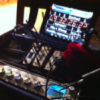-
Posts
367 -
Joined
-
Last visited
-
Days Won
2
About Max Futterman
- Birthday 01/01/1
Profile Information
-
Location
Seattle
-
About
Location sound mixer in the greater Seattle area.
-
Interested in Sound for Picture
Yes
Recent Profile Visitors
2,699 profile views
-

Help with understanding Zaxcom ZHD wireless system
Max Futterman replied to Mike H's topic in Equipment
Regarding the 32 bit spec on the page: That’s only the A/D converter. Pretty much all modern A/D converters are 32-bit for a few reasons, one to maximize the accuracy when converting an analog sample to digital, and you can address more data per CPU cycle. It’s then converted to a 24 bit waveform transmitted over the air. 32 bit wireless transmission makes no sense since a signal would be unreliable and likely have unacceptable latency to fit within FCC bandwidth limits. So in short, the 32 bit spec you read is something completely different. -

32-bit for Dialogue: Yay or Nay?
Max Futterman replied to Marc Wielage's topic in General Discussion
Saying 32-bit files have a dynamic range north of 1000 dB is technically true, but kinda wrong. That is the mathematical limit of 32-bit float, but in practice, at best you can record the full dynamic range the preamp is capable of. For 24-bit (and 16 for that matter), each sample records the amplitude as an integer value represented in binary. Because you have 24 bits to work with, the highest value is 2^24, or 16,777,216. Another way to look at it with each sample, 0 dBFS has a value of 16,777,216, and -144dBFS has a value of 0, with all the samples we record coming somewhere in between, though a good deal higher than 0. 0 dBFS is the upper limit because it can't record a higher value, so all the samples just register a value of 16,777,216, hence the clipping sound in the recording. 32-bit float works differently because instead of recording integer values to correspond with the amplitude of each sample, it records that as equations. So on your recording, you set the gain too high and it clips at 0 dBFS. In post, they drop the levels to a more reasonable -10 dBFS, the software just runs the equation again to reconstruct the waveform, which is admittedly pretty cool. As others have pointed out, it's most useful in professional settings for sound effects with a high dynamic range that you can't reasonably adjust for on the fly. And in practice, you're still limited by the preamps and microphone. It doesn't actually make anything sound better and if you know what you're doing as we all do, there is no advantage to recording dialogue at 32-bit. And given all the problems it creates such as added file size (okay, that's negligible these days), lack of compatibility with a lot of common systems, and the fact it's only on prosumer gear and not high end systems, there is no need. I suspect there'll be a push to make it industry standard since non-sound folk just see a higher number and assume it's better quality much to my annoyance. -
They probably can and maybe a software update in the future. Personally, I think they use all the same CPUs because from a manufacturing standpoint, it's probably more cost effective and reduces manufacturing bottlenecks if all three units use the same components. It also makes it easier to maintain the software on all three units, and has enabled them to release three recorders this year with minimal cash spent on R&D. There certainly are advantages to this approach. It's probably why I feel like the 833 is a bit overpowered for what it does, why the power draw and heat for a small light recorder is baffling, especially compared to the Nova or even Sound Devices' own 633.
-

A review of Nova “OneUnit” and mrx214 wireless modules.
Max Futterman replied to RadoStefanov's topic in Equipment
Latency is a little different. I think Lectros are 3.2 ms while Zaxcom XR and ZHD is 6.0 ms. Add a delay for your Lectro inputs to match, otherwise you nailed it. -
It’s entirely possible. Modern Bluetooth is an open standard and has a range comparable to Zaxnet. Zaxnet was invented ages ago when Bluetooth utterly sucked and was only remotely usable for those phone headsets (remember those?) and not much else. So Zaxcom was very prescient in that regard. Today, Bluetooth does have a comparable range and can easily duplicate the functionality of Zaxnet, though Zaxnet is much more transparent in operation. Manually setting group and unit codes, and setting the exact frequency aren’t exactly done on consumer Bluetooth. It will be interesting to see SD and Audio LTD’s implementation.
-

Audio file resolution and standards.
Max Futterman replied to Max Dumesnil's topic in General Discussion
I don't see any change happening simply because for dialog recording, 24/48 can already capture the full range of human hearing with enough resolution that quantization errors when editing (usually done in a 32 bit environment anyway) are inconsequential. Sound effects recording is an entirely different matter though. However, the reasons we settled on 24/48 years ago, namely storage capacity and CPU strain, are non-issues these days. So at some point, we may switch to 32/96 as the standard because we can, but probably not for at least five years. -
Definitely contact the other mixers in your market and match rates, so they'll kick you jobs when they are over booked!
-

Tentacle Sync 'Track E' - New minirecorders with timecode
Max Futterman replied to pillepalle's topic in Equipment
This definitely looks ideally suited for YouTubers who just need a visible lav and an easy way to sync everything. Granted, a COS11 costs more than the unit itself... -
I started in film school, then reaching out to mixers via cold call. This forum and Facebook are probably your best resources. I find this was still very good advice when I decided on a whim to change markets two years ago!
-
Max Futterman changed their profile photo
-
Hey NY mixers and people near that area! December is here when our phones get quieter until spring. Let's celebrate another year by hanging out for an afternoon and networking, talking gear and business, but with beer! Join me at The Strand Smokehouse in Astoria on Sunday, December 14th from 2:30pm till whenever. They got BBQ, and of course, beer. For everyone who arrives before 3:00, I will buy your first beer. Address is 25-27 Broadway just off the Broadway stop on the N line. Please RVSP on the link or text me at (347) 525-7016 so I can get a headcount. Hope to see you there. https://www.facebook.com/events/729546210467534/?ref=2&ref_dashboard_filter=upcoming
-

Uses for Pin 2 (5V supply) on three pin wireless Lemo connector
Max Futterman replied to LarryF's topic in Equipment
^ Soooo surreal. -
Yeah like power laces.
-

Quiet small film studio in manhattan
Max Futterman replied to rafaeldelauz's topic in General Discussion
I've had good experiences at Digital Arts. It's tiny, but damn quiet. It's a pretty good Green Screen stage if that's what you're looking for. http://digitalartsny.com/greenscreen/ -
It's non profit because it sucks and won't make a dime in profit. Then again, 90 percent of all films lose money, so maybe most of Hollywood film is non profit?






